Table of contents:
Virtual Reality Development in Healthcare: Facts and Figures
Trends in VR Technology in Healthcare
Types of VR Apps in Healthcare
Technologies for VR App Development
Today’s adoption of AR/VR technologies are helping to revolutionize business processes, save resources, and in general build more efficient operations across a broad variety of industries. Healthcare in particular has benefited from its successful adoption of Virtual Reality technologies. Mixed Reality Apps are widely used in the practice of medical doctors around the world. Today we can definitely claim that such solutions are not something exceptional, but a common practice.
Virtual Reality Development in Healthcare: Facts and Figures
Trends in VR Technology in Healthcare
Types of VR Apps in Healthcare
Technologies for VR App Development
VR has become a vital tool for education and training of both students and current physicians, as well as assisting in treatment of chronic conditions, precise diagnostics, and many other important facets of healthcare.
In this article, we will examine how VR is used in healthcare, what types of VR apps are possible and how they are built, and eventually how to build your own VR healthcare solution to train caregivers and save patients’ lives.
Healthcare is one of the main industries that will continue to adopt VR widely.
According to a report by Goldman Sachs, the healthcare VR market will reach $5.1 billion by 2025, with North America and Europe expected to be the top regions to adopt VR in the healthcare industry.
Healthcare providers and patients agree that VR is a must for the healthcare industry: 82% of healthcare professionals say VR is an efficient tool for education, and 62% of patients are ready to try VR as an alternative to routine care.
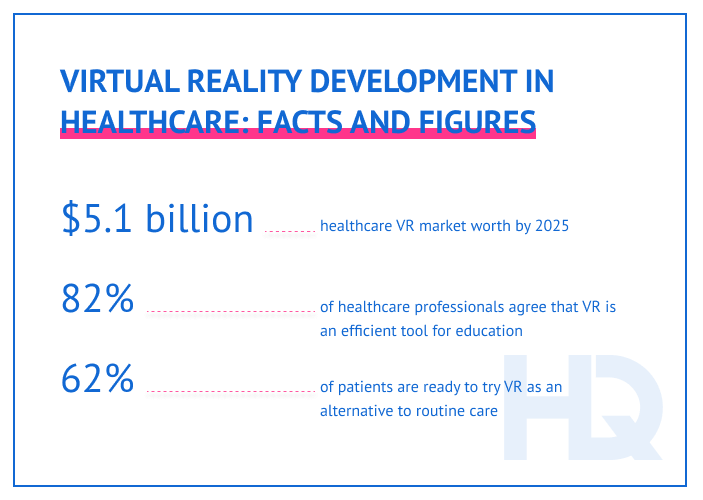
Now let’s see how exactly the healthcare industry adopts VR.
Although VR is still commonly thought of as an entertainment technology, it has become widely accepted in the healthcare industry.
Healthcare VR professionals at your serviceLet’s develop a thought-out healthcare VR solution together – experienced developers are ready to take a look at your ideas!
Anna Halias
Business Development Manager,
HQSoftware
As you can see from the aforementioned statistics, virtual reality app development in healthcare can serve as efficient tools for both patients and caregivers. Here are some ways VR apps are used in healthcare:
VR solutions have been used for some time in healthcare education. Students in all medical fields take advantage of VR technology, using 360-degree video and immersive 3D content to learn new information.
With VR solutions for healthcare, developers create complete learning programs for students and practicing physicians. Using such solutions, students learn new skills and obtain knowledge without risking a patient’s health.
For example, Random42 offers a virtual ride into a human body — floating between blood cells, examining how the neural system works, and so on.
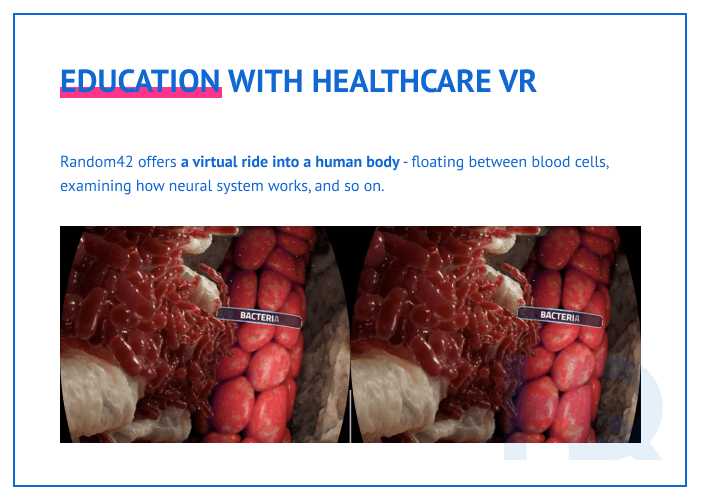
The field of healthcare diagnostics also benefits greatly from Virtual Reality. For example, it is successfully used in neuroscience.
NeuroDotVR is a small, portable device that measures brain activity in response to visual stimulation coming to the patient through a healthcare VR device.
With just a smartphone, a VR headset, and a NeuroDot device, a therapist can measure neuroelectric data to help diagnose glaucoma, amblyopia, and the eye’s ability to adapt to darkness.
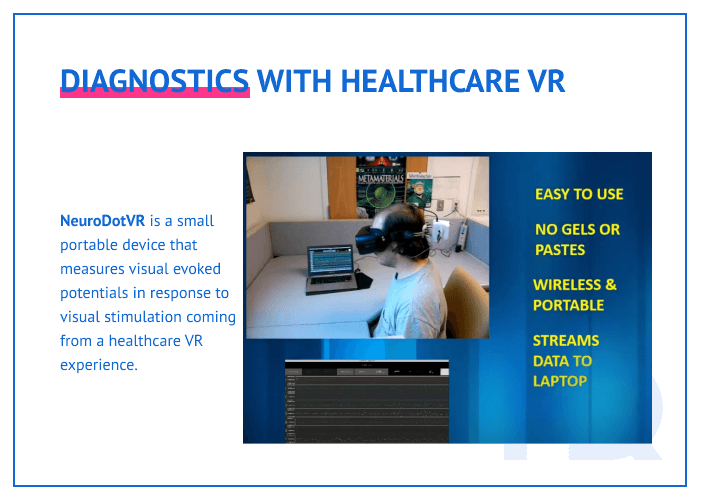
Exposure therapy is one of the most efficient methods for treating certain mental disorders. VR for mental health can enhance exposure therapy and provide therapists with a flexible and low-risk tool.
How do modern businesses use AR to increase their revenues and outperform their industry competitors?
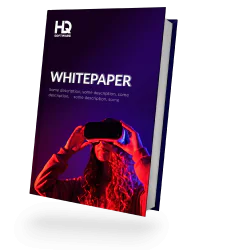
With VR, patients with post-traumatic stress disorder, or PTSD, can receive exposure to the traumatic event virtually. The therapists control what patients experience in the Virtual Reality environment and can alter or stop the process at any time if the patient is uncomfortable.
There is even a term for this: Virtual Reality Exposure Therapy, or VRET.
In addition, VR is a useful tool in treating stress and traumas, phobias, eating disorders, and more. See Psious for reference.
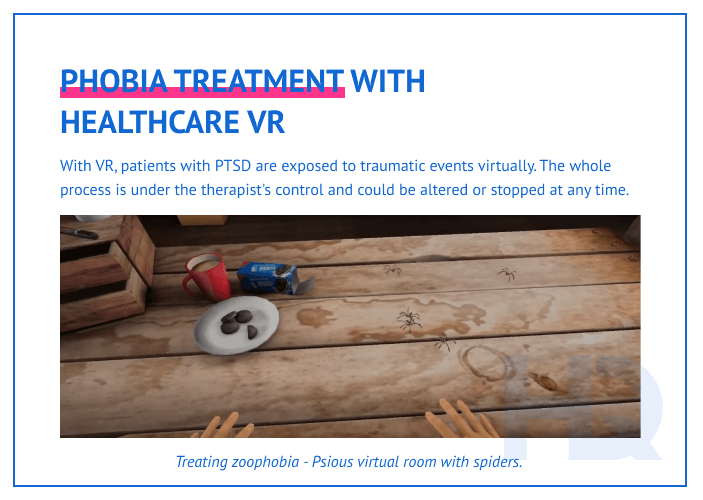
Patients with chronic pain may suffer their whole lives. For a long time, physicians have treated various types of pain by using distraction methods. Now there is Virtual Reality in medicine to revolutionize pain management.
VR apps in healthcare provide a new distraction method — interactive games. The patient is distracted from their pain in a virtual safe space with lots of interactive features. VR is also a solution for those who cannot use drugs for pain management.
BehaVR is one of the companies that focuses on pain management via VR experiences. Their application Balance has proved its effectiveness against chronic pain.
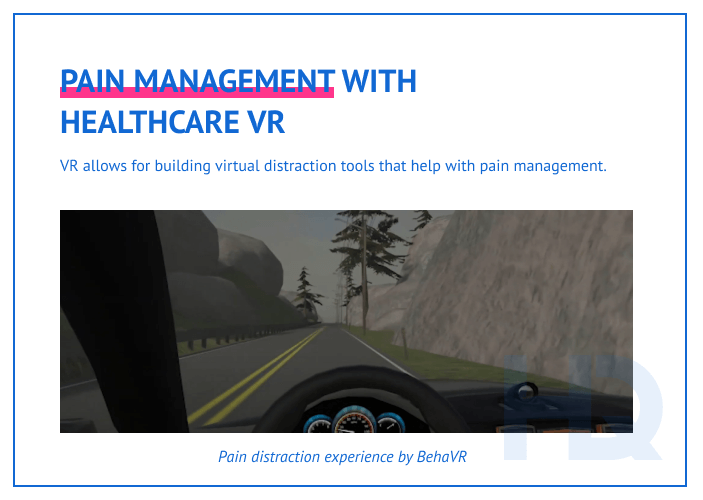
Sometimes fitness programs are a choice; sometimes they’re a necessity. Either way, healthcare VR changes how patients approach getting physical exercise. VR can make getting daily exercise a game rather than an exhausting and dull task.
The Virtual Reality Institute of Health and Exercise studies the effect of Virtual Reality–assisted exercise on the human body. One of the examined healthcare VR apps was ThunderGod; in this simulator, the patient has to regularly extend arms, forcefully hit, catch, and throw objects at virtual opponents.
The game was tested by measuring the metabolic rate of oxygen consumption. Energy expended was 3.41 to 4.22 calories per minute for a patient weighing 60 kg.
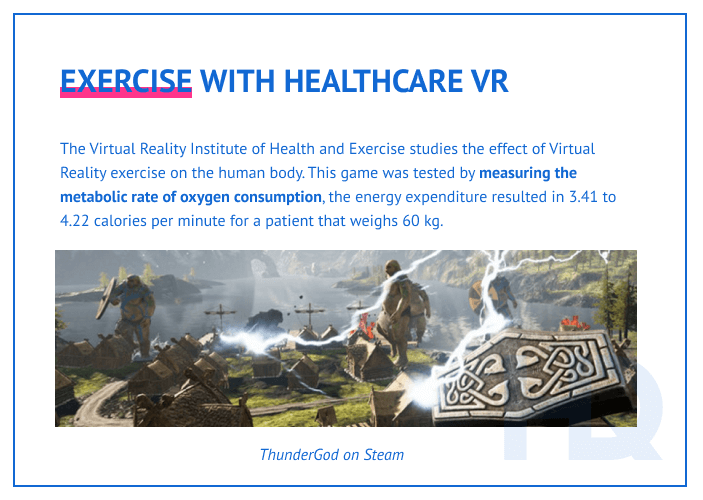
Virtual Reality is not new in the surgical field; it has been used successfully for some time.
For example, Osso VR is a Virtual Reality surgical training and assessment platform. It helps future surgeons learn and train on virtual patients, increasing their confidence in dealing with real patients and shortening the learning curve.
The solution also helps educate surgeons in places that have fewer resources, contributing to solving the global issue of a shortage of surgeons.
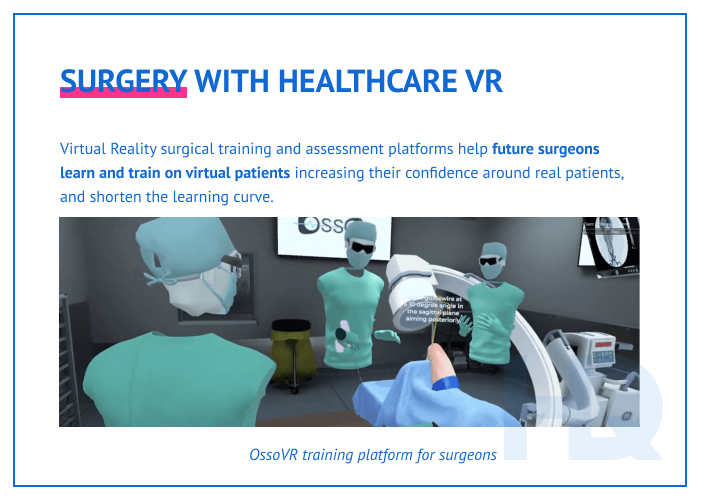
Despite what is already a fairly diverse use of Virtual Reality in healthcare, the technology still has a lot more to offer to medicine in the near future. What’s coming next? Let’s explore some trends.
As mentioned earlier, the healthcare VR market is expected to reach $5.1 billion by 2025. And this is only the tip of the iceberg.
Here are some of the most promising VR healthcare trends:
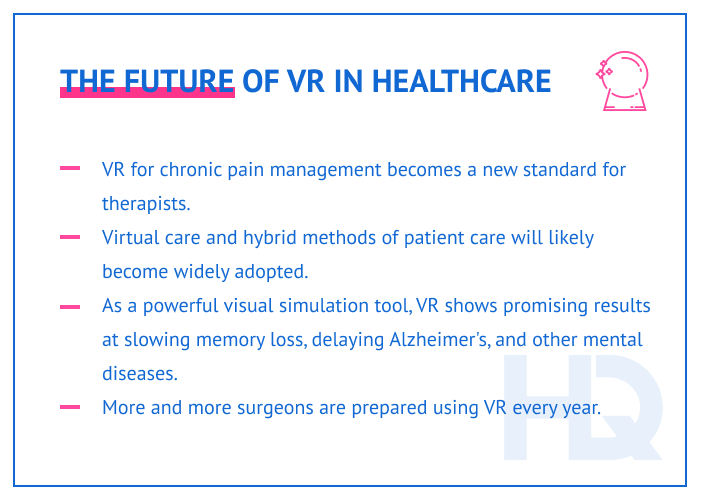
All aforementioned facts and statistics show that VR technology will become even more widely used in the healthcare industry. And though VR apps and their implementation seem very diverse, they have some common operating principles.
So, let’s find out how VR software works.
VR apps in healthcare are built differently depending on the type of application, integrated third-party components, servers and clouds, and so on.
But all VR solutions for healthcare will generally include this architecture:
Here is a chart, for curious readers:
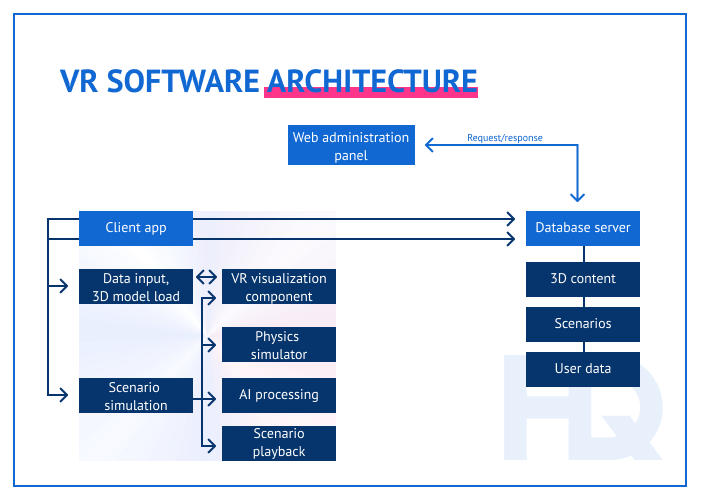
To develop a VR healthcare app, technical specialists usually follow the chart above, but first it’s important to determine the type to be used. Let’s take a look.
There are three types of VR apps in healthcare:
Non-immersive VR apps have limited capacity — they do not replace everything the user sees; images are just displayed on a screen, and the user sees its borders. For example, so-called serious games are widely used in healthcare for training and educational purposes. They have proved their efficiency in enhancing surgeons’ motor skills, attention, and eye-hand coordination.
Semi-immersive VR apps in healthcare replace what the user sees only partly. The user still can distinguish the real world from the simulation easily. This category of VR apps in healthcare is successfully used to improve rehabilitation in patients with chronic pain and injuries.
Fully immersive VR apps in healthcare completely replace the real world for the user. For example, the Oxford Medical Simulation for nurses allows for training nursing skills in a completely virtual environment, with no real-world objects involved.
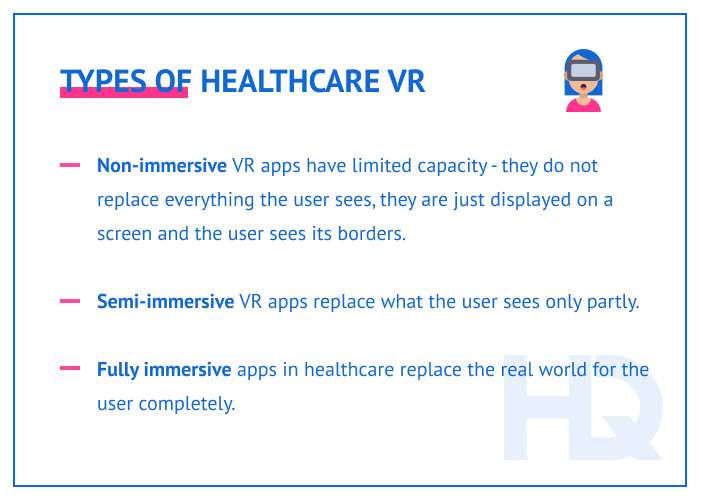
After determining the type of VR application, there is one more step to take — choosing which technologies to use for VR app development. Let’s talk about that next.
To develop a VR app, several things need to be defined:
In the table below are the most commonly used options for each point.
| VR engine | Unreal Engine, Unity, CRYENGINE |
| Tools for 3D and simulation modeling | Autodesk Maya, Blender, Autodesk 3D, Autodesk Fusion 360 |
| Development frameworks/SDK | Oculus SDK, GearVR SDK, iOS/Android SDK, WebVR, React VR, Google VR |
| Hardware | Samsung Gear VR, Oculus Rift, HTC Vive, Google Cardboard / Daydream, PlayStation VR, treadmills, haptic gloves |
| Front-end | HTML, CSS, JavaScript, TypeScript, React, Angular, Vue.js |
| Back-end | Java, PHP, .Net, Python, Node.js |
The chosen technologies greatly affect the complexity of development, the required skills of developers, and the overall cost of an application. So, how much will it cost to develop a VR app for healthcare? Keep reading.
Several important factors affect the cost of VR app development:
For a rough estimate, we will take an average hourly developer rate of $35. Developing a VR application with one well thought-out immersive experience and professional healthcare content will cost around $30,000.
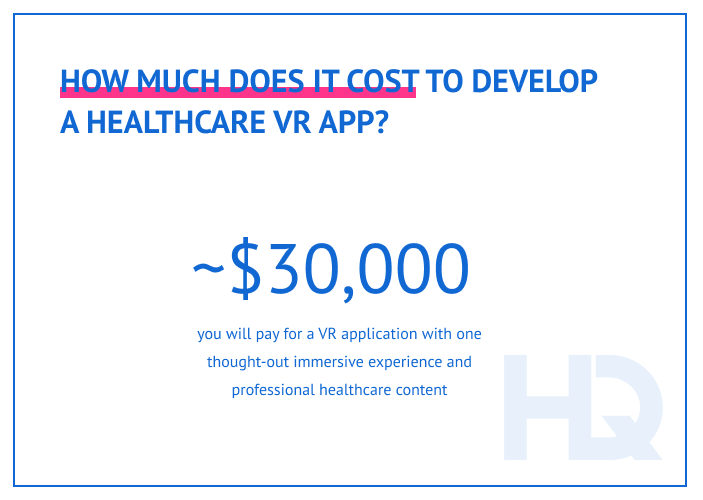
Once you’ve defined key features and technologies of your solution and estimated its cost, you are ready to develop a VR healthcare app. Below we’ll describe the process you may go through if you choose to outsource development.
At HQSoftware, before we begin to actually develop a VR healthcare app we spend time consulting with the client about their needs.
Consulting on VR solutions in healthcare
Consultations to develop a VR healthcare app usually consist of the following steps:
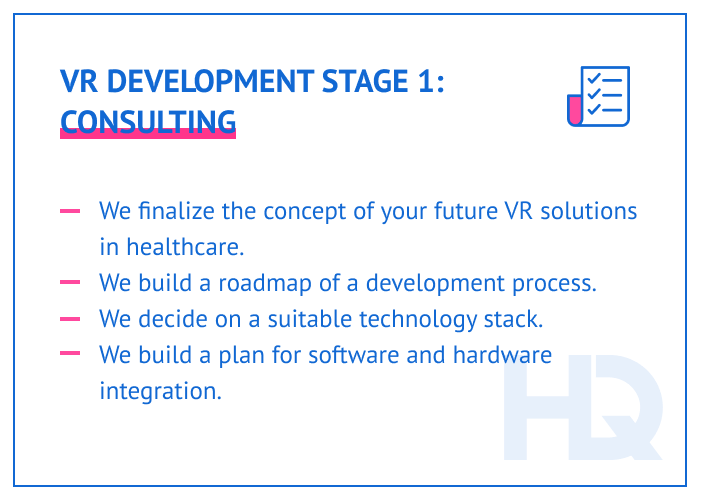
Once these steps are complete, we are ready to develop a VR healthcare app.
The VR development team will complete each of these steps:
When these steps are complete, you can enjoy all the benefits of VR technology for your business.
So, if you are interested in developing your own healthcare VR solution, feel free to contact us and start the development in no time.
We are open to seeing your business needs and determining the best solution. Complete this form, and receive a free personalized proposal from your dedicated manager.

Sergei Vardomatski
Founder